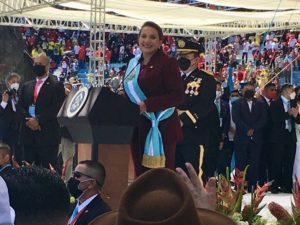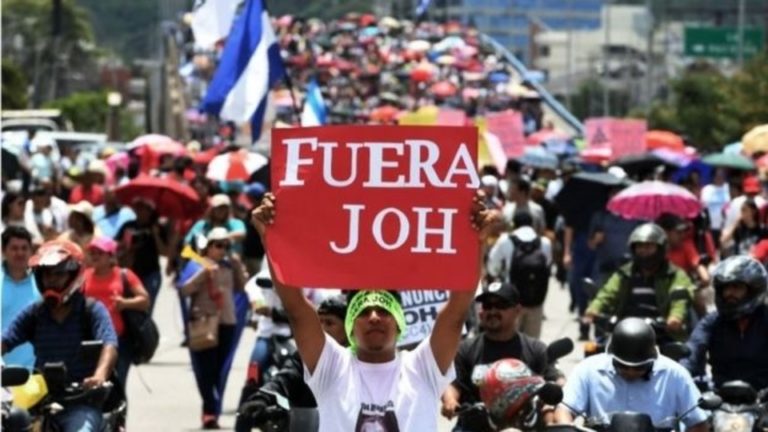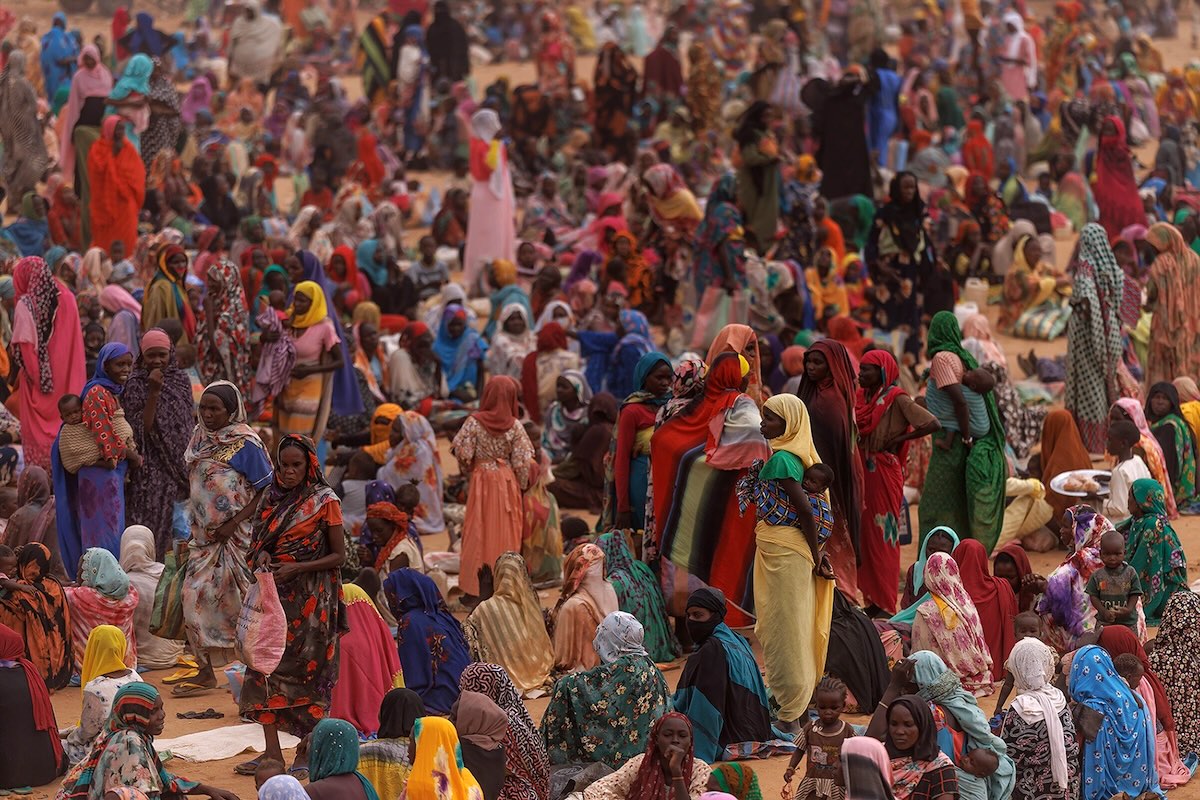On Thursday, April 20, former Honduran President Juan Orlando Hernández (JOH) was escorted to a plane bound for the United States by a team from the U.S. Drug Enforcement Agency to face criminal charges in the United States for drug trafficking and other crimes. As the plane ascended, a crowd of Hondurans cheered and breathed sighs of relief. It marked the end of years of large popular protest demonstrations and shouts of “Fuera JOH” (away with JOH).
Embed from Getty Images
The U.S. requested Hernandez’ extradition from Honduras several weeks ago. He will face charges in New York. His brother, Tony, is already in a U.S. prison after being convicted of massive drug trafficking from Honduras into the United States. In the coming days, the former head of the Honduran police, Juan Carlos (“El Tigre” the tiger) Bonilla, will also almost certainly be extradited to the United States to face similar charges. In addition, there are now more than 40 other extraditions of former Honduran politicians or prominent figures pending, all of them related to drug trafficking and related criminal activity.
This is a dramatic fall from power and impunity for Hernandez and many of his allies and associates. In last November’s election, his National Party lost the presidency and control of the Honduran Congress. Seventy percent of eligible Hondurans voted, by far the largest turnout in the country’s history. By a decisive margin, they elected Xiomara Castro as the first woman to become Honduran President. A large majority of the Honduran people were determined to remove Hernandez whom they accused of turning Honduras into a narco-dictatorship. The new government has pledged to combat drug trafficking, rampant corruption, and violence, especially violence against women.

Control of the Honduran Congress also changed from the National Party to the coalition of parties allied with the new President. The government and the new Congress have already passed significant legislation to remove oppressive laws that aided corruption under Hernandez. They have repealed secrecy laws that had prevented Honduran citizens from seeing where public funds were going. They approved an amnesty law for those who were jailed under the JOH regime for engaging in peaceful protest, Some have already been released from prison under the amnesty law. The new government also intends to disband the National Security Council that Hernandez had created. It was composed of heads of all three branches of government and the military command, and was under the direct control of Hernandez himself, giving him power over all the official instruments of government. The new Congress is making good on a campaign promise to repeal the law permitting the construction of foreign economic zones (Special Economic Development Zones, or ZEDEs) in Honduras that are not subject to most Honduran laws, police, or restrictions. There are currently three such Zones in Honduras, but the large majority of Hondurans, including legal experts, oppose them as a violation of Honduran sovereignty.
As Hondurans cheered and celebrated the departure of Hernandez on April 20, I recalled a similar scene in a neighboring country more than forty years ago. On July 17, 1979, the longtime dictator of Nicaragua, Anastasio Somoza, fled the country in a private plane. His family’s 45 years of U.S.-supported brutal rule over Nicaragua had finally been overthrown by a popular revolution led by the Sandinista Front. Yesterday, with Hernandez’ extradition to the U.S., was for many Hondurans a sort of parallel in Honduras to the Dia de Alegria (Joyful Day) when Somoza left Nicaragua. The similarity does not end there. The new Honduran government will face a mountain of problems and obstacles, but with the support of the large majority of the people, as did the Sandinistas in Nicaragua in 1979.
Embed from Getty Images
In both countries, the looming question now, as then, is how the United States will intervene. In the 1980s, that intervention meant the expansion of U.S. military presence, the imposition of a national security state, and increasing foreign investment in Honduras. The country became the platform for U.S. intervention into Nicaragua. In Nicaragua after the victory of the 1979 revolution, U.S. intervention took the form of the Contra War. The U.S. trained and supported Nicaraguans to wage a war of terror in an attempt to force the Nicaraguan people to abandon the revolution and the Sandinista government.
That war killed 30,000 Nicaraguans and injured—physically and emotionally- thousands more. Media propaganda was part of the intervention in both countries. The Reagan Administration portrayed Honduras as a democratic partner in the fight against communism. It portrayed revolutionary Nicaragua as a communist dictatorship bent on spreading marxism to its neighbors. Incredibly, Reagan told Americans that the Nicaraguan army was only a few day’s march from the U.S. border and could invade the United States.
For the past decade, as Hernandez has ruled Honduras and the Sandinistas have again governed Nicaragua, in both countries United States intervention has been partly economic, but in opposite ways. More ‘aid’ and investment is planned and encouraged for Honduras to retain foreign control of the political economy and in a largely misguided effort to reduce Honduran immigration to the U.S.. The root causes of this migration lie in the rapacious exploitation of Honduran resources by foreign companies and extractive projects that have effectively taken economic resources away from Hondurans and turned them into sources of wealth for foreign interests and a few wealthy Honduran families. More of the same aid and investment will only feed the monster. Biden’s immigration plan calls for significantly more aid and investment in Central America, and a partnership with the new Honduran government.
What this really means, and how it is put into practice will tell us a lot about whether the new Honduran government will have a chance of creating a more equitable, less corrupt, and more peaceful society, or whether the U.S. will simply support more of what it did during the years of the Hernandez regime.
U.S. intervention in neighboring Nicaragua has taken an opposite form to that in Honduras
The U.S. Congress has approved a series of stringent economic sanctions (e.g., the so-called RENACER Act) that will be felt by increasingly broad sectors of the Nicaraguan population. The sanctions are accompanied by a quiet, ongoing funding of opposition groups in Nicaragua through innocent-sounding organizations linked to the CIA and other U.S. agencies.
Embed from Getty Images
There is also a media campaign that portrays Nicaragua as a brutal dictatorship while ignoring any good news about the country. This media campaign ignores news about how international organizations rate Nicaragua as fifth in the world—after the Scandinavian countries—in promoting gender equality; a world leader in converting its economy to renewable energy; a country that produces most of its own food; the second most desired tourist destination in Latin America; and much more—all despite enduring U.S. economic sanctions. This is nearly the opposite trend from what has happened to Honduras in the past decade that left that country with a 70 percent poverty rate.
In Honduras today, human rights organizations are guardedly optimistic about the ability and will of the Xiomara Castro government to begin to reverse and heal the damage caused by Hernandez and the rampant extractive economy and narco-trafficking that marked his governance. People wonder how and why the United States, which had supported the coup that brought people like Hernandez to power in Honduras in 2009 and faithfully supported his government for a decade, could now turn on him so completely, asking for his extradition and leading him away in handcuffs and disgrace. Perhaps, they say, his construction of a powerful narco-state became an embarrassment and an impediment to U.S. influence and investment in Honduras.
Many Hondurans, including human rights leaders, regard the extradition of Hernandez to the U.S. as a mixed blessing. It is a great relief to see him go, but much of the power structure that he helped create remains embedded in Honduras, especially at the local and regional levels. And the massive corruption his rule encouraged has left the new government with a huge foreign and domestic debt and a population in great need of the public services and jobs that were lost in the past decade—conflicting demands on scarce public financial resources. This situation presents a serious temptation to the new government to accept more foreign aid with strings attached. Some Hondurans also point out that it took U.S. intervention to bring Hernandez to justice. They lament the apparent inability of Honduran institutions to do that. For them, this is another example of the influence and control of the United States in Honduran life.
Hondurans and we, their friends, will monitor the course of events in this cautiously optimistic time fraught with potential problems. What is already accomplished is significant: the Honduran people managed to end a destructive and oppressive “dictatorship” (their word) at the ballot box.


